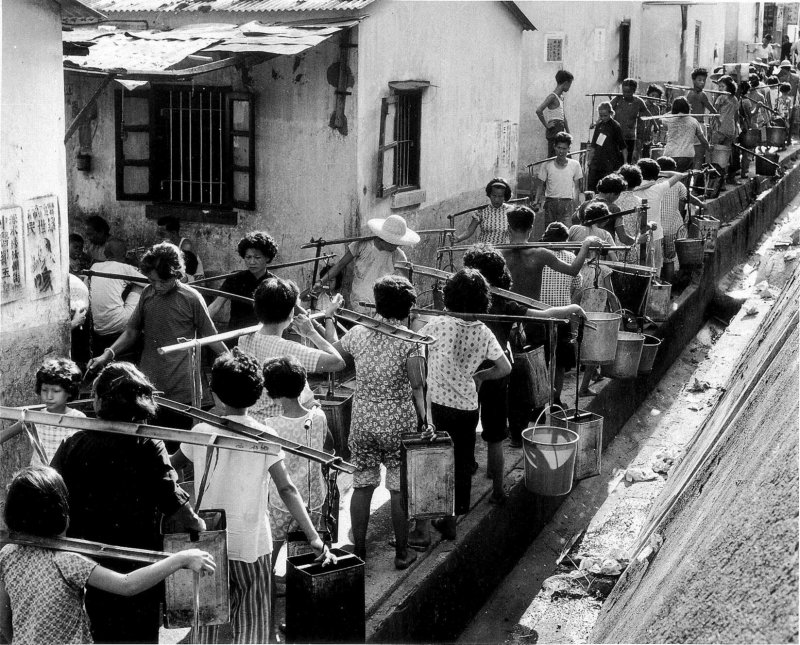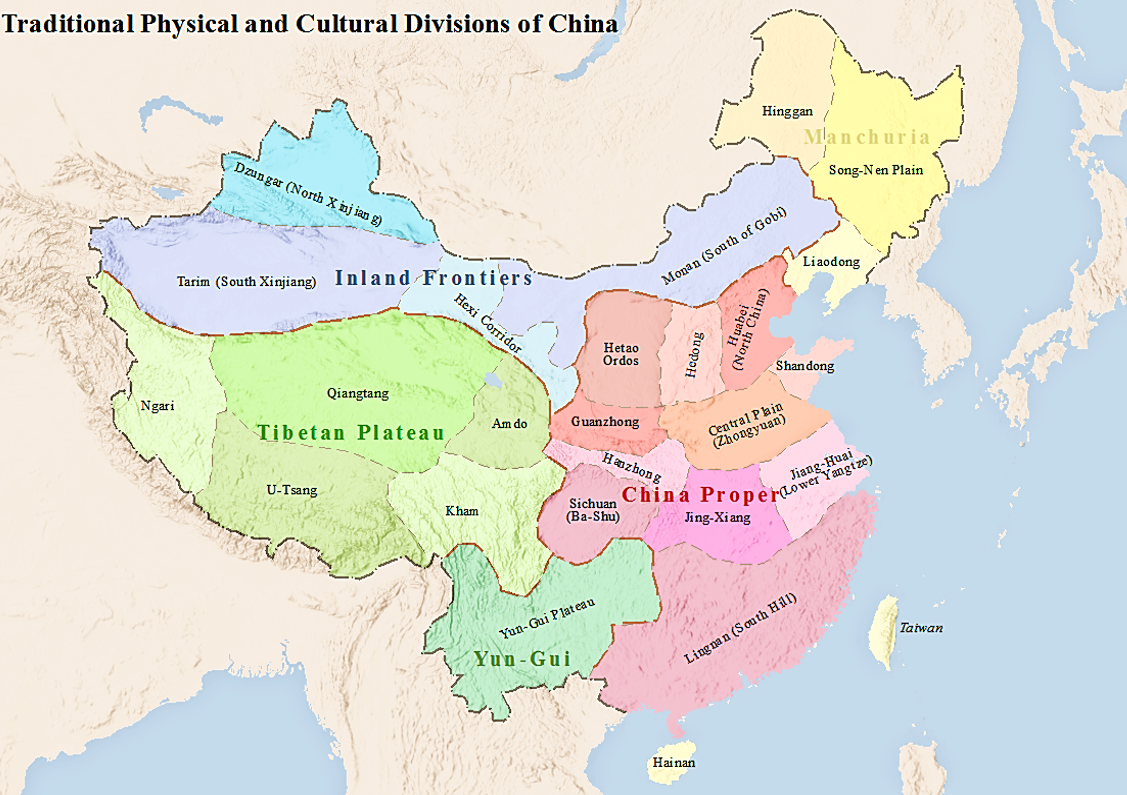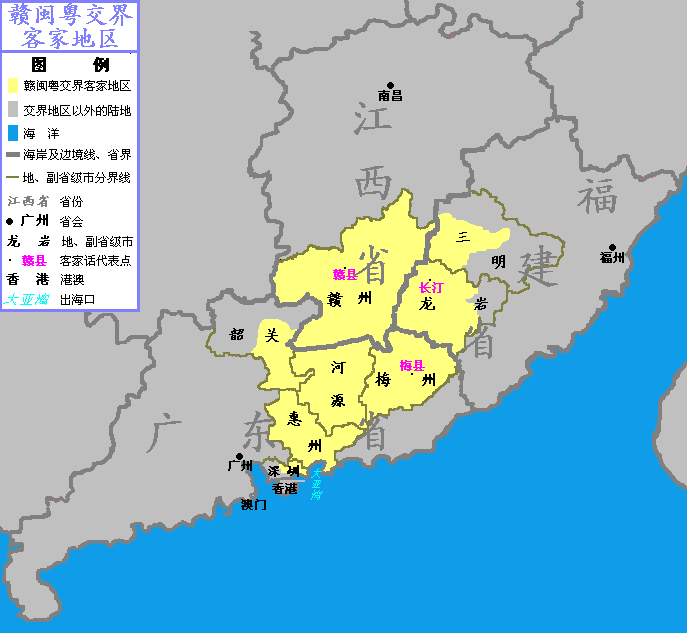|
Dong Jiang
The Dong River is the eastern tributary of the Pearl River (China), Pearl River in Guangdong province, southern China. The other two main tributaries of Pearl River Delta, Pearl River are Xi River and Bei River. The headwater is located in Mount Sanbai () in Anyuan County, Jiangxi. The Dong River is a major source of water for megacities in Pearl River Delta, including Hong Kong, Shenzhen, and Guangzhou. The Hong Kong Government has water supply in Hong Kong, purchased Dong River water from Guangdong since 1965. Over 70 percent of domestic water in Hong Kong is imported from the Dong River. Its discharge totals roughly . Historical findings A dinosaur egg fossil dated back to the Late Cretaceous was discovered by primary school student named Zhang Yangzhe while playing near the Dong River in 2019 in July. The boy's mother, Li Xiaofang, later contacted the Heyuan Dinosaur Museum members, and under their excavation guidance more than 10 dinosaur egg fossils each about 9 centimete ... [...More Info...] [...Related Items...] OR: [Wikipedia] [Google] [Baidu] |
Dongguan
Dongguan (; ) is a prefecture-level city in central Guangdong Province, China. An important industrial city in the Pearl River Delta, Dongguan borders the provincial capital of Guangzhou to the north, Huizhou to the northeast, Shenzhen to the south, and the Pearl River to the west. It is part of the Pearl River Delta built-up (or metro) area with more than 65.57 million inhabitants as of the 2020 census spread over nine municipalities across an area of . Dongguan's city administration is considered especially progressive in seeking foreign direct investment. Dongguan ranks behind only Shenzhen, Shanghai and Suzhou in exports among Chinese cities, with $65.54 billion in shipments. It is also home to one of the world's largest shopping malls, the New South China Mall,Utopia, Part 3: The World’s Largest Shopping Mall ... [...More Info...] [...Related Items...] OR: [Wikipedia] [Google] [Baidu] |
Water Supply In Hong Kong
Water supply and sanitation in Hong Kong is characterised by water import, reservoirs and treatment infrastructure. Though multiple measures were made throughout its history, providing an adequate water supply for Hong Kong has met with numerous challenges because the region has few natural lakes and rivers, inadequate groundwater sources (inaccessible in most cases due to the hard granite bedrock found in most areas in the territory), a high population density, and extreme seasonable variations in rainfall. Thus nearly 80 percent of water demand is met by importing water from mainland China, based on a longstanding contract. In addition, freshwater demand is curtailed by the use of seawater for toilet flushing, using a separate distribution system. Hong Kong also uses reservoirs and water treatment plants to maintain its source of clean water. History Water rationing Until 1964 water rationing - the act of limiting water usage for each households by water providers - was a cons ... [...More Info...] [...Related Items...] OR: [Wikipedia] [Google] [Baidu] |
List Of Rivers In China
This incomplete list of rivers that flow through China is organized according to the body of water into which each river empties, beginning with the Sea of Okhotsk in the northeast, moving clockwise on a map and ending with the Arctic Ocean. Sea of Okhotsk * Heilong River (黑龙江) (Amur River) **Ussuri River (乌苏里江) ***Muling River (穆棱河) *** Songacha River (松阿察河) ** Songhua River (松花江) *** Ashi River (阿什河) *** Hulan River (呼兰河) *** Second Songhua River(第二松花江) *** Woken River (倭肯河) *** Mudan River (牡丹江) *** Nen River (嫩江) ****Gan River (Inner Mongolia) (甘河) ***Huifa River (辉发河) ** Argun (额尔古纳河) ***Hailar River (海拉尔河) ***Hulun Lake(呼伦湖) ****Kherlen River (克鲁伦河) ****Buir Lake(贝尔湖)(mostly in Mongolia) Sea of Japan * Suifen River (绥芬河) / Razdolnaya River (Russia) * Tumen River (图们江) ** Hunchun River (珲春河) Bohai Sea *Anzi River (鞍子河) *Fuzho ... [...More Info...] [...Related Items...] OR: [Wikipedia] [Google] [Baidu] |
Geography Of China
China has great physical diversity. The eastern plains and southern coasts of the country consist of fertile lowlands and foothills. They are the location of most of China's agricultural output and human population. The southern areas of the country (South of the Yangtze River) consist of hilly and mountainous terrain. The west and north of the country are dominated by sunken basins (such as the Gobi and the Taklamakan), rolling plateaus, and towering massifs. It contains part of the highest tableland on earth, the Tibetan Plateau, and has much lower agricultural potential and population. Traditionally, the Chinese population centered on the Chinese central plain and oriented itself toward its own enormous inland market, developing as an imperial power whose center lay in the middle and lower reaches of the Yellow River on the northern plains. More recently, the coastline has been used extensively for export-oriented trade, causing the coastal provinces to become the lead ... [...More Info...] [...Related Items...] OR: [Wikipedia] [Google] [Baidu] |
Huicheng District
Huicheng District () is a district of Huizhou City, Guangdong Province, China. Huicheng is the northern urban center of Huizhou along with Huiyang as the southern urban center. Administrative divisions Huicheng is responsible for the administration of ten subdistricts and eight towns A town is a human settlement. Towns are generally larger than villages and smaller than cities, though the criteria to distinguish between them vary considerably in different parts of the world. Origin and use The word "town" shares an ori .... References County-level divisions of Guangdong Huizhou {{Guangdong-geo-stub ... [...More Info...] [...Related Items...] OR: [Wikipedia] [Google] [Baidu] |
Boluo County
Boluo County () is a county of east-central Guangdong province, People's Republic of China. It is under the administration of the prefecture-level city of Huizhou, and in 2009, had a population of 813,700 residing in an area of . It borders Yuancheng District, Dongyuan and Zijin counties to the northeast, Huiyang and Huicheng Districts to the southeast, Dongguan to the south, Zengcheng to the west, and Longmen County to the northwest. History In ''Lüshi Chunqiu'', the current Boluo used to be one of the many Yue states without a king before Qin dynasty. The state's name was transliterated as (Simplified: , Fuluo) in Chinese. and it was located nearby Mount Luofu (/). or are the hanzi transliteration of the old Yue language's "people", while or meaans "cave". The current Boluo () is derived from the same old Yue word and therefore means "people in mountain". In 214 BCE after the unification of China by Qin, Fuluo County (傅羅縣) was established. Its name was altered to ... [...More Info...] [...Related Items...] OR: [Wikipedia] [Google] [Baidu] |
Huizhou
Huizhou ( zh, c= ) is a city in central-east Guangdong Province, China, forty-three miles north of Hong Kong. Huizhou borders the provincial capital of Guangzhou to the west, Shenzhen and Dongguan to the southwest, Shaoguan to the north, Heyuan to the northeast, Shanwei to the east, and Daya Bay of the South China Sea to the south. As of the 2020 census, the city has about 6,042,852 inhabitants and is administered as a prefecture-level city. Huizhou's core metropolitan area, which is within Huicheng and Huiyang Districts, is home to around 2,090,578 inhabitants. History During the Song dynasty, Huizhou was a prefectural capital of the Huiyang prefecture and the cultural center of the region. The West Lake in Huizhou was formerly known as Feng Lake. At the age of 59, Su Shi was exiled to Huizhou by the imperial government of Song. When he visited Feng Lake in Huizhou, he found it located in the west of the city and was as beautiful as West Lake in Hangzhou. Therefore, he renam ... [...More Info...] [...Related Items...] OR: [Wikipedia] [Google] [Baidu] |
Yuancheng District
Yuancheng ( is the only district of the city of Heyuan, Guangdong Province Guangdong (, ), alternatively romanized as Canton or Kwangtung, is a coastal province in South China on the north shore of the South China Sea. The capital of the province is Guangzhou. With a population of 126.01 million (as of 2020) ..., China. County-level divisions of Guangdong Heyuan {{Guangdong-geo-stub ... [...More Info...] [...Related Items...] OR: [Wikipedia] [Google] [Baidu] |
Dongyuan County
Dongyuan County () is a county in Heyuan, Guangdong Guangdong (, ), alternatively romanized as Canton or Kwangtung, is a coastal province in South China on the north shore of the South China Sea. The capital of the province is Guangzhou. With a population of 126.01 million (as of 2020) ... Province, China. Transport * Heyuan North railway station on Ganzhou-Shenzhen high-speed railway is located here. County-level divisions of Guangdong Heyuan {{Guangdong-geo-stub ... [...More Info...] [...Related Items...] OR: [Wikipedia] [Google] [Baidu] |
Longchuan County, Guangdong
Longchuan County ( postal: Lungchun; , Hakka: ''Liùngchôn'') is a county of northeastern Guangdong province, China, bordering Jiangxi to the north and on the upper reaches of the Dong and Han Rivers. It is under the administration of Heyuan City, and in 2004 had a population of 870,000 living in an area of . Bordering county-level divisions are Xingning and Wuhua County to the east, Heping County and Dongyuan County to the south and west, and in Jiangxi, Dingnan County and Xunwu County to the north. Administrative divisions Longchuan administers 24 towns: *Laolong () * Sidu () *Huangshi () * Xi'ao () * Chetian () * Beiling () * Liju () * Shanping () * Fengren () * Chiguang () *Longmu () * Huilong () * Tianxin () * Tiechang () * Dengyun () * Tongqu () * Heshi () * Huangbu () * Zishi () * Tuocheng () * Yanzhen () * Xintian () *Yidu () * Mabugang () Transport Longchuan has a developed highway and railway network. Major roads include the China National Highway 205 (G205) an ... [...More Info...] [...Related Items...] OR: [Wikipedia] [Google] [Baidu] |
Heyuan
Héyuán (, Hakka:Fò-Ngiàn) is a prefecture-level city of Guangdong province in the People's Republic of China. As of the 2020 census, its population was 2,837,686 whom 1,051,993 lived in the built-up (''or metro'') area made of Yuancheng urban District and Dongyuan County largely being urbanized. Zijin County itself is quickly being conurbated in the agglomeration. The majority of the people are Hakka. The city includes many rainforests and the largest lake in Guangdong: Xinfengjiang Reservoir. The literal meaning of the city's name is "origin of the river". It has recently been officially titled as the "Hometown of the Dinosaur in China", due to the thousands of dinosaur egg fossils that have been unearthed in its vicinity. Geography Heyuan is located in the north-east region of Guangdong, upper reach of Dong River at its confluence with the Xinfeng River. Its latitude spans 23° 10'–24° 50' N, and longitude 114° 13'–115° 35' E. It borders Huizhou to the south, Ganz ... [...More Info...] [...Related Items...] OR: [Wikipedia] [Google] [Baidu] |
Xunwu
Xunwu County () is a county in the far south of Jiangxi province, People's Republic of China, bordering the provinces of Fujian to the east and Guangdong to the south. It is under the administration of the prefecture-level city of Ganzhou. It was the focus of Mao Zedong Mao Zedong pronounced ; also romanised traditionally as Mao Tse-tung. (26 December 1893 – 9 September 1976), also known as Chairman Mao, was a Chinese communist revolutionary who was the founder of the People's Republic of China (PRC) ...'s 1930 essay ''Report from Xunwu'' which surveyed conditions in the region and related them to Mao's developing theory of Chinese communism. Administrative divisions Xunwu County has 7 towns and 8 townships. ;7 towns ;8 townships Climate References Ganzhou County-level divisions of Jiangxi {{Jiangxi-geo-stub ... [...More Info...] [...Related Items...] OR: [Wikipedia] [Google] [Baidu] |
.jpg)





